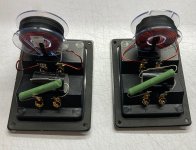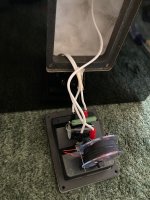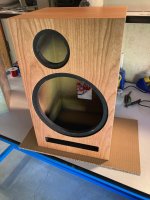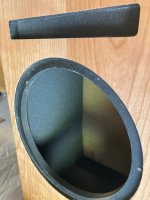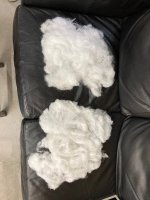"the A26 woofer lacks resolution"
"It lacks resolution because its smooth and easy to listen to."
i am currently using the old 25fewx, the original 25few (the pre historic a26) but with a stronger magnet, and i do not feel it lacks resolution, it do sounds butter smooth but it also let me hear deep into the recording, and it can handle complex music without sounding strained, i think it is an excellent driver. i have them partnered with celestion cds and dayton h6512 horns
"It lacks resolution because its smooth and easy to listen to."
i am currently using the old 25fewx, the original 25few (the pre historic a26) but with a stronger magnet, and i do not feel it lacks resolution, it do sounds butter smooth but it also let me hear deep into the recording, and it can handle complex music without sounding strained, i think it is an excellent driver. i have them partnered with celestion cds and dayton h6512 horns
The original A25 woofers should all be the same drivers, at least the ones I've come across. They sound better than the newer A26 IMO. Most likely due to the cone formulation, but it depends on how well the driver has aged.
The biggest issue with the newer A26 woofer is relatively high IMD. That has alot to do with the extra Le built into the VC. It also hides alot of the midrange breakup the driver has, but its the tradeoff you have running a large driver that high. I would have rather used a simple LP inductor than have that 4 layer VC, which changes inductance constantly as it moves, adding most of the distortion. The other issue is the small motor, but that is needed to get a higher Qes for better low end extension.
I still think the newer A26 clone with the T35 or CAT378 HF is decent for a large 2 way when you compare it with many commercially available speakers. You can listen to it all day long and not get burned out. I like it alot for home theater use, as it takes the rough edge out of dialog and still delivers better fidelity than most home theater setups. While not the best for analytical listening, it fills the need as an everyday speaker that can handle most anything you may listen to more casually.
The biggest issue with the newer A26 woofer is relatively high IMD. That has alot to do with the extra Le built into the VC. It also hides alot of the midrange breakup the driver has, but its the tradeoff you have running a large driver that high. I would have rather used a simple LP inductor than have that 4 layer VC, which changes inductance constantly as it moves, adding most of the distortion. The other issue is the small motor, but that is needed to get a higher Qes for better low end extension.
I still think the newer A26 clone with the T35 or CAT378 HF is decent for a large 2 way when you compare it with many commercially available speakers. You can listen to it all day long and not get burned out. I like it alot for home theater use, as it takes the rough edge out of dialog and still delivers better fidelity than most home theater setups. While not the best for analytical listening, it fills the need as an everyday speaker that can handle most anything you may listen to more casually.
So, this is funny to me. Yesterday I took my Seas A26 speakers with my weird series crossovers to a friend's house to compare to some others, in his system (Spendors, Triangles, I forget which models). The thin-ness of the treble of the A26 was immediately obvious. I quickly swapped the A26 to the standard parallel crossover and they sounded much, much better in his system. Back home, with parallel crossover in my home system, and I'm missing all the bass I've grown to love. I'm really tempted to put my series crossover back in as is but I think also I'm going to order parts for the Havard crossover. I have some 6.8uF Solen caps, hope those are close enough, they might cross the woofer a touch higher but that might work for me.
Post script- I just put my Aleph 20 amp clone in (low Zout, using with the standard parallel crossover) and the bass came right up, if a bit less precise & punchy than I recall with the series crossovers & high Zout amp combinations. I still believe there's something to the control over woofer resonance given by the 22 ohm shunt resistor. I might add this to the Havard crossover.
I built the Håvard crossover. The coils I sourced are a little bit on the low inductance side, spec'd at 0.25mH and measuring more like 0.22mH instead of the 0.26mH called by the design, but the resistor and cap are correct at 8.2 ohms and 5.6uF. Initial sound impressions downstream of an F1J (LU1014Ds as differential pair gain devices) is of a smoother and more even sound than my earlier series crossover. The bass I like is there too, prominent and controlled, the shunt resistor I was using seems dispensable here. I like this crossover a lot and plan on much more listening with it.
If you have a pair of these drivers and are disappointed in the bass response, going series crossovers might surprise you.
If you have a pair of these drivers and are disappointed in the bass response, going series crossovers might surprise you.
Attachments
Hello, Just got the internals from Madison for the A26. Cabinets next week.
Thinking of spray adhesive to mount the foam dampening to the sides. Should be fun.
Trip back into the 60's for me!
:>)
Thinking of spray adhesive to mount the foam dampening to the sides. Should be fun.
Trip back into the 60's for me!
:>)
Some folks use a Bitumen product to dampen the inside walls and use some foam on the rear and top .
So many versions depending on your listening "ear" likes...
Really DIY..
So many versions depending on your listening "ear" likes...
Really DIY..
Pictures!! Would love to see your damping material and the polyfill...how you installed.
The Seas docs recommend 50Grams of polyfill per cabinet..and 12 grams for the port...which Madison uses a foam piece the
same as the foam for the damping...
Thanks that would be really awesome!
In the list of parts from Madisonsound it states to cut out 4 pieces 8.25 x 18 " and 4 pieces 8.25 x 9.5"
Thats 8 pieces...sides, top and bottoms...looks like nothing for the rear panel?.
Wondering how to mount the caps internally...some hot glue to their rear foam, some mount just soldered to the cup structure.
Wondering why they dont put foam on the back panel?
The Seas docs recommend 50Grams of polyfill per cabinet..and 12 grams for the port...which Madison uses a foam piece the
same as the foam for the damping...
Thanks that would be really awesome!
In the list of parts from Madisonsound it states to cut out 4 pieces 8.25 x 18 " and 4 pieces 8.25 x 9.5"
Thats 8 pieces...sides, top and bottoms...looks like nothing for the rear panel?.
Wondering how to mount the caps internally...some hot glue to their rear foam, some mount just soldered to the cup structure.
Wondering why they dont put foam on the back panel?
Ah man, it turns out I didn't take as many pictures as I thought, just a few showing the cabinets before I glued in the foam, and some with foam glued in. Here they are.
The most important thing I think, is drill pilot holes. The MDF used in these cabinets is high quality, and I've swapped out the binding post cup multiple times without noticeable loss in the bite of the wood screws (it's where I mount crossovers), but there's no point pushing one's luck and getting a crack in the MDF because there wasn't a pilot hole.
Per the Madisound instructions, I just spray-glued the edges of one of the included pieces of foam and mounted it over the back of the aperiodic vent. I didn't attempt to source mesh screen material and layer any polyfill between like some of the pictures suggested.
My first build was using the standard crossover, the 3.3uF series cap + 10R resistor on the tweeter, with nothing on the midwoofer. It lacks bass, as some here will tell you 🙄. When I went to series crossovers, first mine and then later the Havard crossover, which I run now, I doubled the volume of polyfill to help with the damping. I had to buy extra to do that, and what's shown is basically the pile that Madisound sent plus the pile I added, for a single cabinet. I think it helped. The bass response with the Havard crossover, as well as the phase coherency between the drivers, is solid.
The most important thing I think, is drill pilot holes. The MDF used in these cabinets is high quality, and I've swapped out the binding post cup multiple times without noticeable loss in the bite of the wood screws (it's where I mount crossovers), but there's no point pushing one's luck and getting a crack in the MDF because there wasn't a pilot hole.
Per the Madisound instructions, I just spray-glued the edges of one of the included pieces of foam and mounted it over the back of the aperiodic vent. I didn't attempt to source mesh screen material and layer any polyfill between like some of the pictures suggested.
My first build was using the standard crossover, the 3.3uF series cap + 10R resistor on the tweeter, with nothing on the midwoofer. It lacks bass, as some here will tell you 🙄. When I went to series crossovers, first mine and then later the Havard crossover, which I run now, I doubled the volume of polyfill to help with the damping. I had to buy extra to do that, and what's shown is basically the pile that Madisound sent plus the pile I added, for a single cabinet. I think it helped. The bass response with the Havard crossover, as well as the phase coherency between the drivers, is solid.
Attachments
- Home
- Loudspeakers
- Multi-Way
- SEAS A26 Devore Style Build
